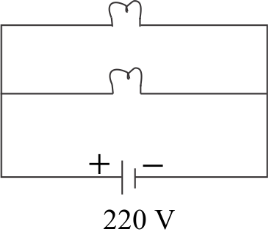Question
Question: Two lamps one rated \[60W,\;220V\] and the other \[40W,\;220V\]are connected in parallel to a \[220V...
Two lamps one rated 60W,220V and the other 40W,220Vare connected in parallel to a 220V electric supply mains. What is the total current drawn from the electric mains if the voltage of electric supply is220V?
Solution
We should check whether the bulbs are arranged in series or in parallel. We should know that voltage will be constant in a parallel circuit and current is constant in series circuit.

Complete step by step answer:
Parallel circuit is a closed circuit in which the current divides into two or more paths before recombining to complete the circuit.In parallel, both bulbs have the same voltage across them. The bulb with the lower resistance will conduct more current and therefore have a higher power dissipation and brightness. Most household electrical wiring bulbs are wired in parallel.
We have given two lamps in such way:
Power of Ist lamp, P1=40W
Voltage of Istlamp, V1=220V.
Power of 2ndlamp, P2=60W,
Voltage of 2ndlamp V2=220V
We know one thing.
Power = RV2 [When potential difference is same then considerP=RV2]
So, resistance of Istlamp, R1=P1V12
=60(220)2=6048400 =806.67Ω
Resistance of 2ndlamp, R2=P2V22
Now question said,
Both lamps are parallel.
So,
⇒Req1=R11+R21 ⇒Req1=806.671+12101 ⇒Req1=1210×806.671210+806.67
Reff=484Ω
Now, current drawn from electrical supply, i = potential difference/Req.
=484220V=4420=115
So, the correct answer is Itotal=115Amp = 0.4545Amp.
Note:
In a parallel circuit, charge is divided up into separate branches such that there can be more current in one branch than there is in another. Nonetheless when taken as a whole, the total amount of current in all the branches when added together is the same as the amount of current at locations outside the branches.
